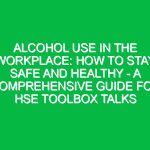Welcome team,
Today, we are here to discuss a crucial topic that directly impacts our daily operations and overall safety – Achieving Safety Goals. Ensuring that we meet and exceed safety goals is not just a responsibility but a commitment to each other’s well-being and the success of our Health, Safety, and Environment (HSE) initiatives.
Importance of Achieving Safety Goals
Before we delve into the specifics, let’s understand why Achieving Safety Goals is paramount in our work environment. Safety goals serve as the roadmap to preventing accidents, reducing risks, and fostering a culture of safety consciousness. By achieving these goals, we not only protect ourselves but also create a secure and efficient workplace for everyone.
Main Content
Potential Hazards and Risks
As we go about our daily tasks, it’s essential to be aware of potential hazards and risks that may arise. Whether it’s working at heights, handling equipment, or dealing with hazardous materials, each task carries its own set of risks. By focusing on Achieving Safety Goals, we can proactively identify and mitigate these risks before they escalate into accidents.
Best Practices and Procedures
To achieve safety goals effectively, we must adhere to best practices and established procedures. This includes wearing proper personal protective equipment (PPE), following safety protocols, and participating in regular safety training. By consistently following these practices, we create a safer work environment for ourselves and our colleagues.
Practical Tips for Safety
Here are some practical tips to help us achieve our safety goals:
- Conduct regular safety inspections of work areas
- Communicate openly about safety concerns
- Stay vigilant and report any unsafe conditions immediately
- Take breaks when needed to prevent fatigue-related accidents
Illustrative Examples
Imagine a scenario where a team member notices a potential safety hazard but fails to report it. This oversight could lead to a serious accident that could have been prevented. By actively engaging in Achieving Safety Goals, we can avoid such incidents and ensure a secure working environment for all.
Employee Engagement
Now, I’d like to hear from you. What are some ways we can collectively work towards achieving our safety goals? Your input and commitment play a vital role in upholding our safety standards and fostering a culture of continuous improvement.
Regulations and Standards
It’s important to note that Achieving Safety Goals aligns with various regulations, standards, and company policies. Compliance with these guidelines not only ensures our safety but also fulfills our legal obligations as responsible team members. By staying informed and adhering to these standards, we contribute to a safer work environment for everyone.
Conclusion
In conclusion, Achieving Safety Goals is a shared responsibility that requires our unwavering commitment and dedication. By prioritizing safety in all our actions and decisions, we not only protect ourselves but also uphold the values of our team. Thank you for your attention and dedication to safety. Let’s work together to achieve our safety goals and ensure HSE success.


